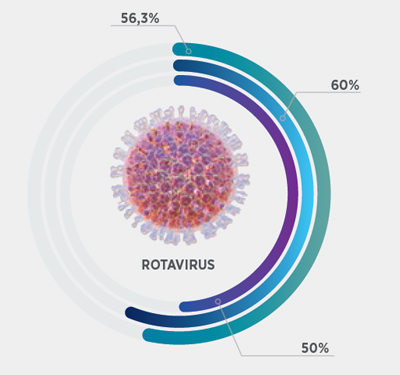
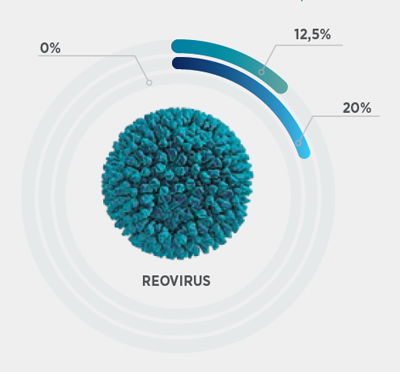
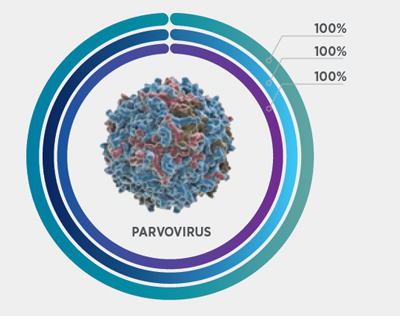
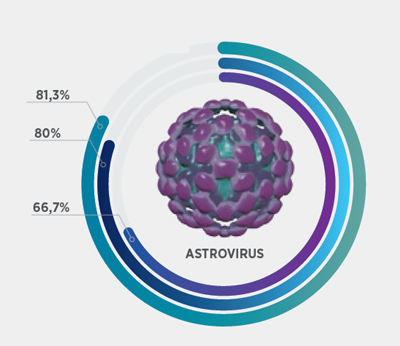

Content available at:
Español (Spanish) Português (Portuguese (Brazil))
Few aspects of runting stunting syndrome (RSS) have been clearly defined, and it is possible that this syndrome is a multi-factor one. In this syndrome, a significant proportion of individual birds are observed for being too small.
RSS was originally described around the 1970’s. Since then, there has been much speculation about the possible role of genetics, management, environment, nutrition and diet, infectious agents or a combination of these and other possible factors.
The involvement of different enteric viruses has been suspected; among others, we can find the following:





There are many possible causes of stunted growth and loss of uniformity. In the case of RSS, stunting is evident from 5-6 days of age. Mortality does not increase per se, but does “appear” to do so due to the culling of delayed birds. There is profuse watery diarrhea that quickly wets the litter and the chickens appear feverish and do not consume food. Affected birds may take an additional 1-2 days to fully consume the starter feed.
Microscopically: Lesions include formation of cysts in the Lieberkühn crypts of the intestine, shortening and fusion of intestinal villi, and infiltration with inflammatory cells.
Macroscopically: The small intestine is pale, with very thin walls, with watery content and poorly digested feed . The liver is small, dark in color and without fat reserves. The gallbladder may be full of bile.
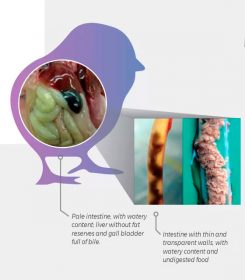

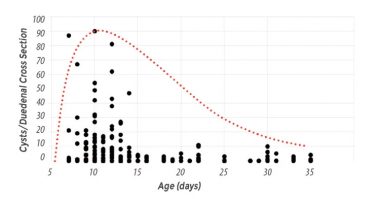
Duodenums of 511 chickens representing 6 integrations with RSS problems were examined in the southern United States. The graph clearly illustrates that the highest incidence of RSS injuries occurs between 7 and 14 days of age.
During this migration, cells specialize to form three main types of cells:
If the crypt cells cannot divide and populate the villi epithelium, then the villi will gradually shorten as the cells age without being replaced by new cells that the crypts should continue to generate. This phenomenon reduces the ability of the intestine to digest, absorb and use nutrients.
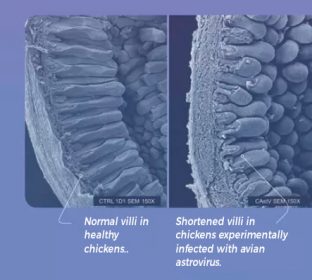
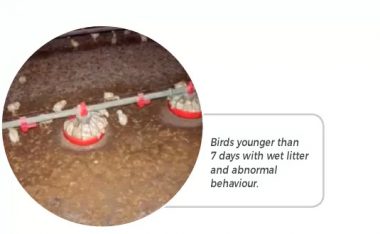
Numerous intestinal viruses have been detected, with astroviruses and reoviruses being the most relevant.
Some autogenous reproductive vaccines are intended to generate passive immunity for progeny, but the results have not been consistently positive. Therefore, it is essential to seek other control measures.
Through research conducted at the University of Georgia, it was possible to determine that, among other management factors, those that cause the most impact are sanitary breaks, reuse of litter and rearing at low temperatures. The possible involvement of infectious agents was also studied. The greatest positive impact was achieved by extending the sanitary break to at least 18-21 days on highly contaminated farms. A very aggressive cleaning and disinfection program was implemented and the reuse of the bed was interrupted. Infectious dwarfism was also observed to be dramatically exacerbated when birds cool in the first days of life. Therefore, it is essential to adhere to good management practices that do not allow the birds to cool down and encourages feed consumption and discouraging the consumption of litter.
Finally, the thickness of the litter turned out to be a determining factor for the reduction of the syndrome. That is, it is important to have at least 10 cm of litter thickness, especially on repeater farms.
A very clear proof of the infectious nature of RSS was represented by a series of experiments in which sibling chicks from the same batch of breeders, incubated in the same incubator and born in the same hatcher, were housed separately in a perfectly environment clean and disinfected and with new litter, and in an environment where there was contaminated litter from farms severely affected with RSS. The chicks were raised for 10 to 12 days and at the end of this short period a sanitary break time of just two days was allowed. In this short period it was allowed either that the contaminated litter remain in the contaminated environment or that the clean environment be subjected again to thorough cleaning and disinfection, in addition to providing it with a new litter before housing a new group of experimental chicks. This process was repeated 27 times and in 100% of the cases, the birds housed in a contaminated environment showed; at 10 or 12 days of age, a 50% lower body weight than their sibling counterparts housed in a clean environment .
This illustrates the important role that biosecurity, cleaning and disinfection have in the control of RSS.
A final aspect that can contribute substantially to the reduction of RSS problems is to seek fermentation and heating of the contaminated litter. Within the aforementioned series of experiments, heating the litter to 40 ° C for 100 hours was shown to reduce the negative impact of RSS on subsequent flocks. In practice, if we can implement an effective litter composting program, it will be possible to reduce the viability of infectious agents that partake in RSS.
CONCLUSIONS
In summary, the most important actions to control infectious dwarfism syndrome include:
Subscribe now to the poultry technical magazine
AUTHORS

Layer Longevity Starts at Rearing
H&N Technical Team
The Strategy for a Proper Infectious Bronchitis Control
Ceva Technical Team
Elevate Hatchery Performance with Petersime’s New Data-Driven Incubation Support Service
Petersime Technical Team
Maize and Soybean Meal Demand and Supply Situation in Indian Poultry Industry
Ricky Thaper
Production of Formed Injected Smoked Chicken Ham
Leonardo Ortiz Escoto
Antimicrobial Resistance in the Poultry Food Chain and Novel Strategies of Bacterial Control
Edgar O. Oviedo-Rondón
GREG TYLER INTERVIEW
Greg Tyler
Insights from the Inaugural US-RSPE Framework Report
Elena Myhre
Newcastle Disease: Knowing the Virus Better to Make the Best Control Decisions. Part II
Eliana Icochea D’Arrigo
Avian Pathogenic E. coli (APEC): Serotypes and Virulence
Cecilia Rosario Cortés
The Importance of Staff Training on Animal Welfare Issues in Poultry Industry
M. Verónica Jiménez Grez
Rodent Control is a Key Factor in Poultry Biosecurity and Sustainability
Edgar O. Oviedo-Rondón